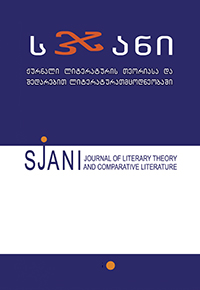გოეთეს სწავლება ურფენომენზე და მისი რეცეფცია გრიგოლ რობაქიძის შემოქმედებაში
Goethe’s Theory of Proto-Phenomenon (Urphänomen) and Its Reception
in Grigol Robakidze’s Literary Works
Author(s): Konstantine BregadzeSubject(s): Literary Texts
Published by: ლიტერატურის ინსტიტუტის გამომცემლობა
Keywords: proto-phenomena; mythos; modernism; poetics; ontological novel.
Summary/Abstract: 1. The article deals with one of the most important aspects of Grigol Robakidze’s (1880- 1962) works, in particular the pioneering attempt for the reception of Proto-Phenomenon (Urphänomen) of an eminent German classic writer, Johann Wolfgang Goethe (1749-1832). From this standpoint, Robakidze’s two texts are analyzed in the paper: a philosophical essay “Proto- Fear and Mythos” and a novel “Snake Skin”. 2. The article proceeds with the viewpoint that Goethe’s notion of Urphänomen is established on the one hand, as a creative process and on the other hand, an ideological foundation therefore, this conception represents one of the philosophical and aesthetic foundations alongside Georgian mythical and linguistic world-image. 3. The author considers that from purely philosophical-existential standpoint Robakidze did perceive Goethe’s notion of Urphänomen as an ideological basis for solving the issues of existence (alienation with metaphysical-mythical foundations, impossibility of self-identifi cation, existential fear and dehumanization) of a modernist human - it is Archibald Macleish’s mutual evolution – forward and backward, as it is in Goethe’s Urphänomen in relation to the evolution of separate empirical plant – which serve as an existential salvation for modernist human and a way to overcome proto-fear. 4. According to the conclusions drawn by the author of the article, from the standpoint of effective realization and hermeneutics of onto-existential issues of post-modernist human and his aesthetic mood and readiness, studies of Goethe’s Urphänomen is appropriate even nowadays. G.Robakidze was the fi rst who placed emphasis on the philosophical reception of Goethe’s notion in the early 20th century Georgian and western culture. He implemented this reception on the basis of which he later formed and published his own hermeneutic in the form of philosophical and aesthetic discourse. 5. From ideological standpoint, three types of narratives can be singled out in modernistic texts (Z. Shatirishvili): individualistic (liberal), esoteric and revolutionary, each of them representing three controversial viewpoints covering onto-existential issues (alienation, impossibility of self-identifi cation, fear of existence, dehumanization) of a modernist human. In my opinion, Robakidze’s “Snake Skin” displays esoteric as well as liberal (individual) narratives simultaneously. These two dimensions coexist within the text of a novel and therefore we can speak about two types of narratives – on the one hand, esoteric and on the other hand, individualistic. Later in Robakidze’s works, in particular “The Killed Soul”, esoteric narrative disappears completely and the text of a novel is presented as a typical individualistic narrative, where the onto-existential lack of prosperity of a modernist human is revealed (Bregadze 2010: 45-46).
Journal: სჯანი
- Issue Year: 2011
- Issue No: 12
- Page Range: 142-161
- Page Count: 20
- Language: Georgian

